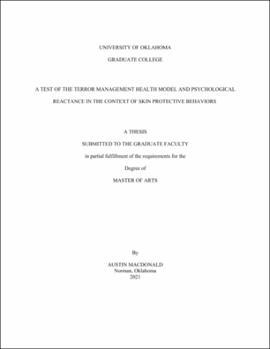| dc.description.abstract | This thesis presents the results of an experiment (N = 206) that utilized sun overexposure prevention messages and a 2 (mortality: salient, control) × 2 (freedom threat: high, low) independent-group design. The study tested the terror management health model (Goldenberg & Arndt, 2008) and integrated its predictions with the theory of psychological reactance (J. W. Brehm, 1966) to examine the effects of mortality salience on proximal defenses. When mortality is salient, proximal terror management defense can help motivate individuals to engage in adaptive health behaviors. Conversely, when direct, freedom-limiting messages are used in persuasion, individuals can become reactant and fail to adhere to risk mitigation messages. However, using freedom limiting messages to address health concerns that activate death awareness may help mitigate reactance, resulting in adaptive, body protective behaviors. Consistent with this reasoning, study results revealed that mortality salience significantly increased intentions to wear sunscreen all year around relative to the control (dental pain) condition. However, the effect of mortality salience on the intention to purchase high or low-SPF lotions was not significant. In addition, a main effect of mortality salience on threat-to-freedom perceptions was marginally significant and indicated that mortality salience generated less threat to freedom perceptions. This finding suggests that mortality salience can mitigate threat to freedom perceptions that are part of reactance. Finally, a significant interaction between freedom threat and mortality salience on behavioral intention to purchase a high-SPF lotion showed that, when a high threat-to-freedom message was paired with mortality salience, intentions to purchase a high-SPF lotion were significantly higher as compared to the low-threat-control condition, indicating that mortality salience mitigated the maladaptive effects of reactance. These results provide a handful of insights and future directions for research to improve risk and crisis communication efforts. In situations where individuals are faced with explicit, freedom-limiting messages, tailoring alert/prevention messages by making mortality salient can help maximize adherence to self-protective claims and increase overall message effectiveness by avoiding unintended reactance effects.
Keywords: reactance, terror management health model, terror management theory, freedom threat, death, persuasion, mortality salience, sun exposure, tanning, skin cancer prevention | en_US |
